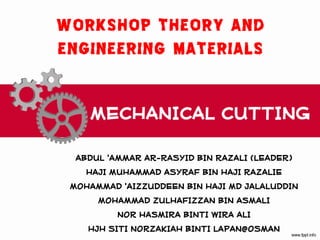
WORKSHOP THEORY AND ENGINEERING MATERIALS CUTTING
- 1. WORKSHOP THEORY AND ENGINEERING MATERIALS MECHANICAL CUTTING ABDUL ‘AMMAR AR-RASYID BIN RAZALI (LEADER) HAJI MUHAMMAD ASYRAF BIN HAJI RAZALIE MOHAMMAD ‘AIZZUDDEEN BIN HAJI MD JALALUDDIN MOHAMMAD ZULHAFIZZAN BIN ASMALI NOR HASMIRA BINTI WIRA ALI HJH SITI NORZAKIAH BINTI LAPAN@OSMAN
- 2. INTRODUCTION • M echanical cutting is one way of splitting a workpiece into two, to plastically press a shape out of it, such as with blanking. • This entry deals with splitting a workpiece into two by removing a thin slice of material by mechanical means (the other main approach is removal by intense heat). These processes are usually called "sawing" and include: hacksaws, bandsaws, circular saws and friction saws.
- 3. QUESTIONS 1. Describe the principle upon which mechanical cutting is based. 2. Explains the basic difference between: Hand Shears Guillotine or bench shears Shear Machine Nibbler 3. Explains the maximum thickness of mild steel plate that can normally be cut by bench shears.
- 4. 1. Describe the principle upon which mechanical cutting is based. 1. Cutting Speed • The cutting speed can be defined as the relative surface speed between the tool and the job. It is a relative term since either the tool or the job or both may be moving during cutting. It is expressed in m/min. 2. Feed • It may be defined as the relatively small the cutting tool relative to the work piece in a direction which is usually perpendicular to the cutting speed direction. It is expressed in mm/rev or mm/stroke. • It is more complex element as compare to the cutting speed. It is expressed differently for various operations. 3. Depth of cut • The depth of cut is the thickness of the layer of the metal remove in one cut or pass measured in a direction perpendicular to the machine surface. The depth of cut is always perpendicular to the direction feed motion.
- 5. 2. Explains the basic difference between:
- 6. A) HAND SHEARS • Hand shears are more efficient than the conventional two-handed shears; here you can use one hand for snipping and the other for holding and collecting the greenery, while the long pointed blades make them far more versatile than secateurs.
- 7. HAND SHEARS
- 8. B) GUILLOTINE OR BENCH SHEARS • A bench shear, also known as a le ve r she ar, is a bench mounted shear with a compound mechanism to increase the mechanical advantage. It is usually used for cutting rough shapes out of medium sized pieces of sheet metal, but cannot do delicate work. • The guillotine is a machine for beheading by means of a heavy blade that slides down in vertical guides.
- 9. BENCH SHEAR
- 10. GUILLOTINE
- 11. C) Shear Machine • Shear machine is a process which cuts stock without the formation of chips or the use of burning or melting. strictly speaking, if the cutting blades are straight the process is called shearing; if the cutting are curved then they are shearing-type operations. Most common sheared materials are in the form of sheet metal or plates, however rods can also be sheared. • Shearing type i. Blanking ii. Piercing iii. Roll slitting iv. Trimming
- 12. SHEAR MACHINE
- 13. D) Nibbler • A nibbler is a tool for cutting sheet metal with minimal distortion. One type operates much like a punch and die, with a blade that moves in a linear fashion against a fixed die, removing small bits of metal and leaving a kerfs approximately 6 mm wide. Another type operates similar to tin snips, but shears the sheet along two parallel tracks 3–6 mm apart, rolling up the waste in a tight spiral as it cuts. Nibblers may be manual (hand operated) or powered. • Power nibblers are often powered by compressed air, though electrical types also exist. A common nibbler tool is an electrical drill attachment, which converts the rotary motion of the drill into a reciprocating motion of the jaw.
- 14. NIBBLER
- 15. 3. Explains the maximum thickness of mild steel plate that can normally be cut by bench shears. The Angle cut has a maximum rating of 0.5mm thick mild steel and 2.6mm round wire stock. The angle cut feature is a 90o template with a separate blade located on the lower part of the shear underneath the cutting table opposite of the handle.
- 16. CONCLUSION • From this presentation you can understand what are the principle of metal cutting machines used in workshops, when they are used and at what condition.